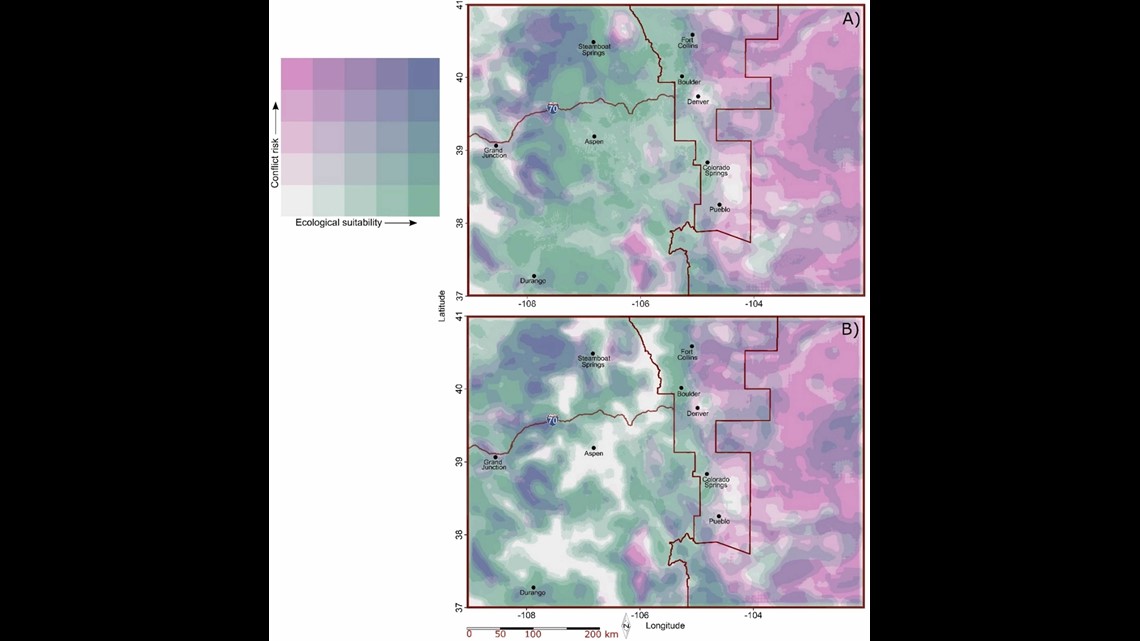COLORADO, USA — New research, published Monday, predicts where wolves could eventually thrive in Colorado. U.S. Forest Service Research Ecologist Dr. Mark Ditmer pinpointed wildernesses near Aspen: Hunter-Fryingpan and Collegiate Peaks.
"If they’re staying in large wilderness areas they’re less likely to be moving through public lands or causing potential conflict,” said Ditmer.
It's a forward-looking analyses, because first Colorado needs to have wolves reintroduced.
"Wolves do really well in wilderness areas, but they also can do well living alongside people too, if there’s, you know, not too much conflict,” said Ditmer.
He studied that too.
RELEASE LOCATION RESEARCH
CPW plans to release gray wolves by the end of the year because of a 2020 vote, while wildlife officials continue to look for a source to provide wolves. Ditmer has not found another vote in the U.S., like Colorado's, to reintroduce a large mammal.
"It's really kind of unprecedented in conservation," Ditmer said.
After that vote, Ditmer, and researchers from Colorado State University, took on the unprecedented question of where CPW should release wolves. They spent about eight months analyzing data.
They studied locations based on two criteria: ecological suitability and conflict risk.
"Where are their main prey species? Where can they hunt well? Where is there not too much snow that’s going to limit where the wolves can hunt and things like that,” is how Ditmer explained the meaning of ecological suitability.
Ecological suitability was challenging to study, since wolves were nearly eradicated from the Rocky Mountains in the 1940s.
"We don’t have any actual animal data to really validate our assumptions," Ditmer said.
Conflict risk means the chances of wolves having issues with livestock and humans. For this, Ditmer found more than three million data points.
“Having this data of how people actually voted for or against this effort is really unique," Ditmer said.
He used precinct-level data from the 2020 vote to calculate the chances of conflict for wolves and people.
"The idea being where people supported it more, people will be more willing or more tolerant to live alongside wolves," Ditmer said.
WHERE WOLVES CAN BE RELEASED
The state cannot just release wolves anywhere. State law said wolves must be released west of the Continental Divide.
CPW will release wolves at least 60 miles from a sovereign tribe's land, or a neighboring state. That is at their request and due to how far wolves can travel.
CPW cannot release wolves on federal land. They can only be released on state-owned, or private land.
WHERE WOLVES WILL BE RELEASED
Combining ecological suitability and conflict risk, Ditmer studied the whole state. A good habitat depends on the season. The bottom picture is the winter.
White: An area with low conflict, but a poor habitat. Ditmer says these are generally areas of higher elevation. Some areas where wolves could do well in the summer, turn to uninhabitable in the winter.
Pink: High conflict, bad habitat.
Green: Places with a good habitat and low conflict.
Purple: Good habitat, but high conflict. Ditmer says these would be the worst places the state could put wolves.


Using this Ditmer, zeroed in two larger areas.


For the first release, CPW plans to focus on the top circle: Between Glenwood Springs and Vail and down to Aspen.
"It feels like a lot of pressure to have gotten it right, but you know, we feel like we leveraged the data that are out there as best we could given our knowledge of wolf ecology and conflict in other areas of the Rockies,” said Ditmer.
CPW will not publicize the exact release location for safety reasons. When the state releases wolves, it will be a "hard release," meaning the wolves will be immediately set free to live on their own without food or care.
When wolves arrive, they will be wearing GPS-enabled collars. Ditmer plans to use that data to sharpen his predictions.
"Hopefully us doing research and doing these models will give a leg up and a heads up on where to put those efforts and how to better manage wolves so they can start a viable population with as minimal conflict as possible," he said.
SUGGESTED VIDEOS: Colorado Outdoors

